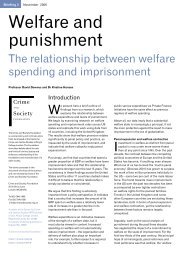The most famous example of this is described inthe book Pygmalion in the Classroom 7 . Rosenthal andJacobson found that teacher expectancies of studentperformance were strongly predictive of studentperformance on standardized tests, and thatmanipulating these educator biases and beliefs couldlead to substantial improvements in student outcomes.Similar so-called ‘Pygmalion Effects’ or expectancylinkedoutcomes have been found in courtroom studies,business schools, nursing homes, and numerousdifferent workplaces 8 . Meta-analyses of studiesconducted both inside and outside the researchlaboratory suggest an average effect size or correlation(r) of over .30 in studies ofinterpersonal expectancy effects 9 .Are there dangers toinculcating children withincremental theory? Sure. It puts alot more pressure on individuals towork hard. Whereas the kid whofails a test in an entity culture cankick back with some satisfactionand say hey ‘It’s not my fault I wasborn this way,’ in an incrementalculture, there is always pressureon you to do better. And this putsa lot of pressure on kids. Ji writes:‘If a Chinese child scored 98 outof 100 on a test, the Chineseparent would likely respond, ‘Howcome you lost two points? Youneed to study harder and scorehigher next time.’’There’s another big risk here,that might be the more importantone: If you believe intelligence isdynamic, then not only can ‘stupid’ people get smarter,but smart people can presumably get ‘more stupider’ too.This is a little experiment my gifted friends and I tried outat university, by basically getting stoned and watchingbad TV all day, and I can testify to its legitimacy. For some,this dynamic nature of intelligence is an awfully scarythought to comtemplate. Still, I think this is a small priceto pay for the advantages that the research literature(again: the empirical research literature) tells us aboutbelief in incremental theory for equality, democracy,fairness. Remember, I am not necessarily arguing thatincremental theory is right (or wrong) empirically, butinstead that promoting the theory produces empiricallybetter results, normatively speaking.Two Views about CriminalityNow, why am I devoting so much attention toeducation research in a talk about throughcare?Obviously, I think a parallel dichotomy can be found inregard to criminal behaviour. Drawing on the work ofDavid Garland and others, I argue that there are twoprimary cultural scripts available in regards towrongdoing:The fact is,criminologists knowa great deal aboutearly childhood riskfactors — includinggenetic andprenatal risk factors— that substantiallyraise the possibilityof someone gettinginvolved in drugsand crime.Moral Essentialism (Entity theory, laydispositionalism, ‘Criminology of the Other’ 10 )The idea here is that criminal behaviour is dueto fixed, unalterabledispositions, traits, innercharacter. Criminalbehaviour is a symptom ofwho a person really is, deepdown, and always will be.Moral Redeemability(Incremental theory, laysituationalism, ‘Criminologyof the Self’)Here, criminal behaviour isseparated from thepermanent nature orcharacter of the person.Criminality is not ‘fixed’ in aperson, the individual canfundamentally change and‘make good’ for what theyhave done in the past.Again, remember, I’m notmaking an empirical argumentin favour of one of these two, very different models ofunderstanding criminality. Just like with intelligenceresearch, criminology has amassed considerableevidence on both sides of this coin. Indeed, one of thebest known theories of crime seeks to account forboth patterns in empirical data on crime in the lifecourse 11 . The fact is, criminologists know a great dealabout early childhood risk factors — including geneticand prenatal risk factors — that substantially raise thepossibility of someone getting involved in drugs andcrime. Further, we know there are these largely stablepersonality characteristics, like low self-control orsome of the characteristics associated with‘psychopathy’, that appear to be deeply implicated in7. Rosenthal, R. and Jacobson, L. (1992) Pygmalion in the Classroom. New York: Irvington.8. Rosenthal, R. (2002) ‘Covert communication in classrooms, clinics, courtrooms, and cubicles’, American Psychologist, 57: 839-49.9. Kierein, N.M. and Gold, M.A. (2000) ‘Pygmalion in work organizations: A meta-analysis’, Journal of Organizational Behavior, 21: 913-28.10. Garland, D. (2001). The culture of control. Chicago: University of Chicago.11. Moffitt, T.E. (1993), ‘Adolescence-Limited and Life-Course-Persistent Antisocial Behavior: A Developmental Taxonomy’, PsychologicalReview, 100, 674-701.24Prison Service JournalIssue 192
criminality and are not thought to be easily modifiedover time. At the same time, we know that there is alarge body of research evidence that people canchange lives of persistent offending. Indeed, for anyof you who have heard of my work, you will know thisis the research I have spent much of the past decadedoing: studying the process of ‘desistance fromcrime’ 12 . In fact, it is estimated that around 85 percentof those people we call ‘criminals’, even ‘careercriminals’, eventually desist from crime according tolongitudinal research 13 .My argument today is different, though. Myargument is that (like with intelligence), regardless ofthe evidence in favour of persistence or desistance incrime, we (as a society, butespecially a justice system) shouldbelieve or at least try to believe ina moral redeemability theory —not just because it is right,empirically, but because doing sois good for society. Again, this is anormative argument (anargument about what is right orwrong), but I make it based onthe empirical, research literature— not the empirical evidence forthe two theories, but ratherevidence regarding theconsequences that adherence toone theory or the other mightlikely have for society (andespecially for ‘offendermanagement’).Like with intelligence, there’sa huge body of social psychology evidence on theconsequences of stability beliefs with moral statuses thatcan support this argument. Research shows that thosewho perceive their ascribed status to be permanent (beit a label such as ‘alcoholic’, ‘mentally ill’, ‘paedophile’,etc.) are most likely to slip into hopelessness, passivity,and retreatism. They are the least likely to make effortsto change themselves for the obvious reason that theydo not think such change is possible 14 . Moreover, weDesisting from crimeis difficultand requiresconsiderable selfbelief.If a personfeels like everyone isagainst them andthat they don’t havea chance in life, well,they probably don’t.know that people’s beliefs on such issues are stronglyinfluenced by those around them.Of course, we know all about this story incriminology. We call this labelling theory and the idea iswell known — young people who are stigmatized intothinking they are no good, turn out to fulfil thisprophecy. Labelling theory fell out of favour politically inthe 1980s, but its redemption — begun by prominentcriminologists like John Braithwaite 15 and Sampson andLaub 16 — has truly come full circle with a recent, awardwinningarticle in the prestigious journal Criminology 17 .Ted Chiricos and colleagues followed the outcomes of95,919 men and women who were either adjudicatedor had an adjudication withheld in the state of Florida,and found that those who wereformally labelled weresignificantly more likely torecidivate within two years thanthose who were not. Similarfindings have repeatedlyemerged in longitudinal cohortstudies from Farrington’sCambridge Study 18 to Bernburg’srecent work with the Rochestercohort 19 to Burnett and LeBel’simportant longitudinal work onex-prisoners 20 . Desisting fromcrime is difficult and requiresconsiderable self-belief. If aperson feels like everyone isagainst them and that they don’thave a chance in life, well, theyprobably don’t.Far less attention has beengiven to the other side of this equation, but presumablyif one can internalise a moral essentialism scriptthrough a process of stigma and self-labelling, thenpresumably one can also be taught to believe in one’sown redeemability. My colleagues and I have called thisprosocial labelling process a ‘Pygmalion effect’ in therehabilitation process 21 . The idea is that if we showindividuals that we believe they can change, they maybegin to believe this themselves.12. Maruna, S. (2001). Making Good: How Ex-Convicts Reform and Rebuild Their Lives. Washington, DC: American PsychologicalAssociation Books.13. Blumstein, A., & Cohen, J. (1987). Characterizing criminal careers. Science, 237, 985-991.14. LeBel, T.P. (2008). Perceptions of and responses to stigma. Sociology Compass, 2: 409-32.15. Braithwaite, J. (1989). Crime, Shame and Reintegration. Cambridge: Cambridge University Press.16. Sampson, R. J. and Laub, J. (1997). A life-course theory of cumulative disadvantage and the stability of delinquency. In Thornberry, T.(ed) Developmental Theories of Crime And Delinquency, Transaction Press, New Brunswick.17. Chiricos, T., Barrick, K. and Bales, W. (2007) ‘The labelling of convicted felons and its consequences for recidivism’, Criminology, 45(3):547-81.18. Farrington, D.P. (1977) ‘The effects of public labelling’, British Journal of Criminology, 17: 112-25.19. Bernburg, J.G., Krohn, M.D. and Rivera, C.J. (2006) ‘Official labelling, criminal embeddedness, and subsequent delinquency: Alongitudinal test of labelling theory’, Journal of Research in Crime and Delinquency, 43(1): 67-88.20. LeBel, T.P., Burnett, R., Maruna, S. and Bushway, S. (2008) ‘The ‘chicken and egg’ of subjective and social factors in desistance fromcrime’, European Journal of Criminology, 5(2): 130-58.21. Maruna, S., LeBel, T., Mitchel, N. and Naples, M. (2004). Pygmalion in the Reintegration Process: Desistance from Crime Through theLooking Glass. Psychology, Crime and Law, 10 (3), 271-281.Issue 192Prison Service Journal25











